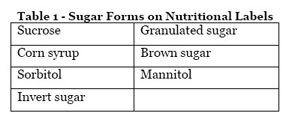Carbohydrates make up the bulk of a healthy diet by providing energy, several vitamins, minerals, fiber and phytochemicals, which are substances in plant foods that support health. They provide four calories per gram and are the chief source of energy for all bodily functions. The brain requires a continuous supply of carbohydrates exclusively (blood sugar) and during exercise carbohydrates are the primary fuel. By consuming adequate amounts, the body receives the energy needed for activity and basic metabolic functions and allows protein to be spared for its primary functions. That is, when adequate carbohydrate is supplied by the diet, lean muscle mass can be preserved and dietary protein is used for supporting the immune function, growth, recovery and other important functions. Unlike fat, the body’s ability to store carbohydrates is limited and must be constantly replenished by the diet.
Carbohydrates are generally classified as sugars (simple), starches (complex) and fiber. Natural sugars (e.g., fructose or galactose) can be found in fruit and milk. Refined or added sugars originate from plant sources such as corn. A monosaccharide is a single sugar unit, such as glucose (commonly referred to as blood sugar), fructose (fruit sugar) and galactose. Disaccharides include sucrose (table sugar), lactose (milk sugar) and maltose. Refined or added sugar (Table 1 and Table 2) is often found in soft drinks, candy and sweet desserts. Most Americans consume adequate amounts of sugar each day. However, consuming foods high in refined or added sugars can lead to excess calorie consumption, particularly when the food is also high in fat and calories. Therefore, try to limit these foods and select more natural sugars found in fruits, vegetables and low-fat dairy. Ideally, added sugars should be limited to no more than ten percent of total daily calories. [1]


Starches are long chains of glucose in plant food. After digestion and absorption, the glucose units that are not used for immediate energy can be put back together in chains and stored in the liver and muscle as glycogen. Sources of starches are grains, legumes, beans and potatoes. The Dietary Guidelines encourage the consumption of whole grains in the diet. They contain more nutrients and fiber than refined products. Fiber is the non-digestible component of the plant. Higher intakes of dietary fiber are associated with lower incidence of heart disease and certain types of cancer.[2,3] Additional benefits of fiber are listed here:[4,5]
- Provides bulk in the diet and slow digestion, thus increasing feelings of fullness [6]
- Prevents constipation and establishes regular bowel movements [2]
- Contains very few calories (cannot be absorbed by the human gut) [7]
High fiber foods tend to be greater in volume, low in fat and low in calories. The recommended daily intake of fiber is 38 grams for men and 25 grams for women, however most Americans only consume half of the recommended intake.[8]
Fiber can be categorized into soluble and insoluble. These differences can explain their effect on health. Soluble fiber (Table 3) partially dissolves in water, forming a gel-like material. This type of fiber has been shown to help reduce cholesterol.[3] Insoluble fiber (Table 4) does not dissolve in water and promotes the movement of food through the gut.[2]

Summary
The recommended range for carbohydrate is 45 to 65 percent of total calories. Choose mostly whole grain sources while limiting the intake of added sugars. Aim for at least 25 grams of fiber every day.
References
1 American Dietetic Association. Position of the American Dietetic Association: use of nutritive and nonnutritive sweeteners. J Am Diet Assoc. 2004 Feb;104(2):255-75. Erratum in: J Am Diet Assoc. 2004 Jun;104(6):1013.
2 Aldoori WH, Giovanucci EL, Rockett HR, Sampson L, Rimm EB, Willett WC. A prospective study of dietary fiber types and symptomatic divertivular disease in men. J Nutr Apr 1998;128(4):714-9.
3 Rimm EB, Ascherio A, Giovannucci E, Spiegelman D, Stampfer MJ, Willett WC. Vegetable, fruit, and cereal fiber intake and risk of coronary heart disease among men. JAMA Feb 1996; 275(6):447-51.
4 Anderson JW, Smith BM, Gustafson NJ. Health benefits and practical aspects of high-fiber diets. Am J Clin Nutr May 1994;59(5 Suppl):1242S-47S.
5 Howe GR, Benito E, Castelleto R, Cornee J, Esteve J, Gallagher RP, Iscovich JM, Deng-ao J, Kaaks R, Kune GA, et al. Dietary intake of fiber and decreased risk of cancers of the colon and rectum: evidence from the combined analysis of 13 case-controlled studies. J Natl Cancer Inst Dec 1992;84(24):187-96.
6 Samra RA, Anderson GH. Insoluble cereal fiber reduces appetite and short-term food intake and glycemic response to food consumed 75 min later by healthy men. Am J Clin Nutr. 2007 Oct;86(4):972-9.
7 Carbohydrates in human nutrition. Report of a Joint FAO/WHO Expert Consultation. FAO Food Nutr Pap 1998; 66:1–140.
8 Liu S, Willett WC, Manson JE, Hu FB, Rosner B, Colditz G. Relation between changes in intakes of dietary fiber and grain products and changes in weight and development of obesity among middle-aged women. Am J Clin Nutr. 2003 Nov;78(5):920-7.